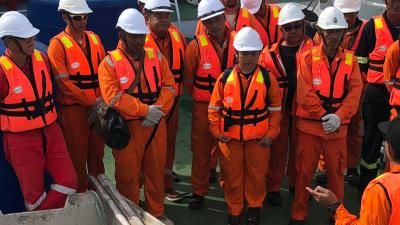
How safe do you feel?
At this year’s Hay Festival, Dr Sarah Cumbers, Director of Evidence and Insight, takes attendees on a journey through the World Risk Poll.
This page is approximately a 5 minute read
This page was published on

Lloyd’s Register Foundation commissioned the Seafarers’ International Research Centre (SIRC) at Cardiff University to carry out a scoping study that begins to investigate how decisions that impact safety at sea are made, and the role that evidence plays in these decisions.
At Lloyd’s Register Foundation, we believe that using insight from the best available evidence leads to better decision-making. And as a charity with a mission to improve safety, we believe that evidence-based, safety-related decision making, ultimately saves lives.
Using evidence to inform our efforts to address the world’s most pressing safety challenges is fundamental to how we operate. Our Evidence and Insight Centre steers and evaluates our grant-giving and also provides a growing repository of openly-accessible information to encourage evidence-based decision-making and practice, especially in safety-critical industries.
Encouraging evidence-based practice requires an understanding of the current use of data and evidence in ensuring safety in critical industries such as maritime.
Drawing on its extensive knowledge of the subject, SIRC mapped the evidence considered by the maritime industry in safety-related decision-making. For the purposes of this study, ‘evidence’ includes academic sources, industry reports, accident investigations, expert opinion and national safety guidance. The full report is available from the SIRC website.
To make the mapping manageable and systematic, the researchers used a ‘horizontal’ and ‘vertical’ segmented approach: the ‘horizontal’ approach explored safety-related decision-making within a selection of organisations that spanned international and national governance and civil society bodies, while the ‘vertical’ approach provided ‘deep-dives’ into decision-making relating to the safety of two specific pieces of equipment: lifeboats and steering gear.
Both approaches combined desk-based research and expert interviews. Taken together, the project considered evidence drawn upon by equipment designers/manufacturers, international and regional regulators, national regulators, international stakeholder bodies, trade unions, and ship operators.
For each of the organisations studied - IMO, European Maritime Safety Agency (EMSA) the national maritime regulators of Malta, Norway, Panama and the UK, Nautilus International, the Nautical Institute, and INTERTANKO - the report documents the degree to which evidence or references are identifiable and/or accessible in relation to decision-making. Highlights include:
Unsurprisingly, the International Maritime Organization (IMO) - the UN body that regulates the international shipping industry - dominates safety-related decision-making across the sector. This is because competition among flag states and companies discourages them from trying to go beyond the minimum standards required by regulation.
IMO does not generate regulations based upon accounts of best practice but seeks to establish minimum acceptable standards taking account of the economic and social context of the shipping industry. In this context, evidence - when visible - is less related to best practice and more related to industry experience (of accidents, for example) and expertise. This type of evidence is inherently reactive rather than proactive.
In comparison, industry bodies representing seafarers and professional standards draw to varying degrees upon academic evidence and the evidence provided by practitioners and seek to influence decision-makers by shaping debates that may impact on regulatory agendas. However, their focus is oriented towards establishing best practice which does not often overlap with the establishment of minimum acceptable regulatory standards.
Hence, the use of evidence to improve safety sector-wide is hampered by a competitive market in which the full value of safety is not realised.
Since the majority of safety-related decision making takes place at IMO, the authors consider this to be the focus of any further study of a more comprehensive nature, and they make several constructive recommendations for conducting such a study effectively.
At IMO, the authors recommend including references to supporting evidence (of any kind) more routinely, which would benefit flag state representatives considering decisions put before them. Visibility of references would help these representatives understand the basis for new proposals and it would allow them to follow-up on the evidence themselves, so that they can arrive at better informed decisions.
This scoping study provides the basis for those wanting to understand and influence the use of evidence in the maritime industry. More immediately, the study provides a robust indication of the current state of affairs with which to raise awareness of the potential for improving safety by increasing the use of evidence in safety-related decision making.
Lloyd's Register Foundation will continue to promote the use of evidence in safety-related decision making and practice in maritime and other industries, especially those that are safety critical or relate to critical infrastructure.
Simultaneously, the Foundation's work exploring the value of safety helps counter under-investment in safety as cost-saving in a competitive maritime sector. By supporting organisations to realise the full value of safety, the Foundation is encouraging the use of evidence of best safety practice that results in proactive safety improvement, sector-wide.
In addition, the Foundation is building capacity in ‘what works’ for safety, which will include working with industry to further understand decision making, and translating evidence into practice on an ongoing basis. The work will also identify and fill gaps in the evidence base of what’s effective (and why) for improving safety, via commissioned research and embedded monitoring and evaluation of safety interventions.
To find out more about any of these initiatives, please contact us at info@lrfoundation.org.uk.